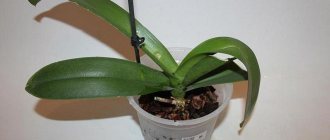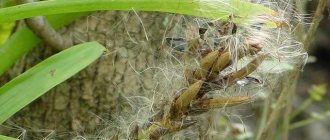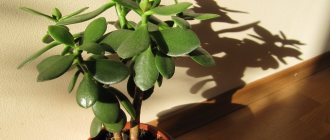Do you have an orchid growing, but you don’t know how to replant it at home? Read the article, it contains a lot of useful tips and instructions.
The orchid, just like the rose, can be called the queen of flowers. Graceful flowers, decorative leaves, intertwining roots and stems create a plant of incredible beauty. But this flower, like all the others, needs good care, an important component of which is replanting. It needs to be done correctly and on time - the further development of the plant and the abundance of flowering, as well as the duration of the adaptation process, depend on this.
Read another article on our website that tells how to propagate an orchid at home with children, cuttings, roots, and seeds. All methods are described in detail.
This article describes the timing, as well as the rules for transplanting a home orchid. You will learn how to replant a flower after the store and why to do it at all. Read on.
Why replant an orchid when grown at home: is it replanted at all, is it possible?
Orchid transplantation at home
Various circumstances may arise under which a transplant is performed. Why replant an orchid when growing it at home? Is it possible to replant at all? Yes, this can and should be done. Here are the circumstances under which flower breeding experts advise doing this:
- Replanting is required once every 3-4 years after purchasing or replanting the plant.
- If it is noticed that the roots have begun to appear from the pot, i.e. it has become too small for the plant.
- If the orchid is very sick, all its leaves begin to turn yellow.
- Unsightly appearance and condition of the substrate in which the flower grows. Mold or severe dryness of the upper fragments has appeared on the surface, which indicates a loss of the filler’s ability to pass water and air.
- The plant does not bloom for several years, and then it needs a good shake-up in the form of a transplant.
- If necessary, divide the orchid.
If these signs are not observed, it is better not to touch the orchid - it does not really like to be disturbed. It is also not recommended to do this during the flowering process; it is better to wait until it is over, unless an urgent transplant is needed.
What kind of substrate can it be?
Soil for orchids must meet the following indicators:
- be moisture-retaining and lightweight;
- do not interfere with the natural normal circulation of air masses near the roots;
- create natural looseness;
- retain nutrients well;
- soil acidity should be from 5.5 to 6.5 pH units;
- dry in at least 3 days;
- facilitate the passage of sufficient lighting.
Important! If the flower grows in a basket, the risk of severe drying out of the soil is quite high. Therefore, the composition of the soil for orchids is supplemented with moisture-retaining components - swamp moss, fern roots and coconut chips.
Timing: when can an orchid be replanted?
Replanting an orchid at home
This operation should be carried out when the dormant period of the inflorescences and the entire plant has ended. But there are types of orchids in which the dormant period is weakly expressed, for example, phalaenopsis, which blooms almost all year round with short breaks. Therefore, if new shoots of a plant do not develop in the absence of signs of disease, it means that it is entering a dormant period. This is the best time to replant. This time usually occurs in the spring - late February and March. This is the best time to replant an orchid.
DIY cooking
All the required components are easy to buy or collect in the forest. When collecting, you must follow some rules:
- Remove bark only from dead trees. Check for the absence of resin, pests, and rot. Peel it and cut into small pieces 1x1 cm and larger pieces 2x3 cm. For disinfection, the bark is treated in a water bath or frozen in the freezer. After all manipulations, it needs to be dried.
- Moss grows in swampy lowlands of rivers and lakes. The collected moss must be cleaned of small debris, dried and cut into strips of 10 cm.
- The coal must be clean. The ideal option is to burn birch wood yourself without adding lighter fluid.
The prepared components are mixed in the proportions required for a particular type of orchid. Video about the features of making soil for phalaenopsis with your own hands:
Components for different types of flower
Each orchid has an individual need for a specific soil. After all, some grow as epiphytes, others settle in the ground.
Phalaenopsis
This orchid requires soil with excellent aeration, completely devoid of nitrogen additives. Required components:
- pine bark;
- moss;
- charcoal;
- fern root;
- peat.
The composition prepared in advance before transplantation cannot be pre-mixed.
Dendrobium
Dendrobium requires soil rich in nutrients. It includes:
- 3 parts pine bark;
- 1 part charcoal;
- 1 part moss;
- 1 part coconut chips.
Wanda
For the health and lush flowering of Vanda, increased nutritional content of the substrate is required. The composition for Dendrobium is taken as a basis and components are included in it in the following ratio:
- 1 part sand;
- 1 part perlite;
- 1 part peat.
The bark is used in small fractions.
Cattleya
Cattleya is unpretentious and does not need a rich soil composition and therefore grows well in clean bark. But to diversify the plant’s nutrient medium, a little moss and coal are added to the substrate. No more than 2-3 pieces.
Miltonia
For Miltonia, harmony in the substrate is the mixing of components in equal proportions. Includes:
- peat crumb;
- fine fraction bark;
- sphagnum moss;
- charcoal.
Frequency of orchid transplantation at home: how often?
Replanting an orchid at home
Many novice flower lovers ask the question: “How often to replant an orchid?” . What determines the frequency of transplanting inflorescences at home?
- The answer to this question depends on what composition of the substrate is in the container.
- It may consist of moss, and then it needs to be replanted more often - once every two years .
- If the main part of the substrate is bark, which decomposes more slowly, then you can replant it once every three years.
Of course, these dates are indicated for planned replantings, when the inflorescence looks completely healthy and has no signs of damage by insects.
How to choose the right composition that is needed?
Phalaenopsis does not require soil; it cannot grow in ordinary soil. It needs a place to strengthen its roots. In his homeland these are trees. Wrapping around the trunk, the flower gets its food from under the bark.
The mixture in which the plant is grown is called substrate. To correctly select the composition of the substrate, it is necessary to focus on the climate, lighting conditions, humidity and temperature in which the plant is accustomed to living.
The composition and structure of the components must correspond to the size and characteristics of the flower, the size of the container, etc. Good growth and lush flowering will depend on the correct selection. It often includes the following components:
- oak or pine bark;
- peat;
- vermiculite;
- perlite;
- conifer cones;
- sphagnum moss;
- charcoal;
- fern roots;
- coconut fiber, etc.
The most popular substrate component used as a base is pine bark . It has excellent aeration and moisture capacity. Many specialty stores offer ready-made mixtures. But flower growers often prepare them themselves. Substrate requirements:
- ease;
- looseness;
- easy air penetration;
- moisture capacity.
When choosing the composition of the substrate on your own, you must remember that artificial components have disadvantages that can affect the health of the flower. Polymers, under the influence of light, air and water, gradually decompose, and as a result, styrene is formed, which harms the flower through the roots.
Most hybrid forms of phalaenopsis have adapted to the traditional composition of the substrate. But full disclosure of species characteristics occurs when home growth and care conditions are as close as possible to the natural habitat. And the main task of the soil is to create the stability of the plant as in its native environment. Therefore, it is important to observe specific proportions and composition of components.
Substrate for orchid transplantation at home: what is it made of?
Substrate for transplanting orchids at home
To transplant orchids at home, you need to choose a high-quality substrate. The health and further flowering process of the plant largely depends on this. What is it made of? You can buy a specialized one at retail outlets, but it comes in two types:
- For epiphytic (i.e. with aerial roots). It's called Phalaenopsis Mixture.
- For terrestrials - “Mixture for Cymbidium”.
The first mixture is used for flowers growing on trees with long aerial roots. Therefore, the substrate for them must be breathable, because the roots of these flowers take part in photosynthesis and they do not need soil, only moisture, to grow. The composition of such mixtures usually includes:
- Pine bark
- Ground fern root
- Activated carbon
- Cut cork
- Sphagnum in small quantities
The second type of mixture is denser, because it is intended for orchids living on the ground. It contains more of these ingredients:
- Sphagnum moss
- Lowland peat
- Leaf ground
- Coal
Sometimes various synthetic materials, such as perlite or foam, are used as a substrate. You can also use:
- Expanded clay
- Shell rock
- Pumice
The substrate can be made at home. Pine bark is used for this:
- First disinfect it - hold it over steam for half an hour or boil it in water.
- After this, dry and boil again. This treatment kills all pathogenic organisms.
- Place to dry again and then cut into pieces up to 2 cm .
To the bark prepared in this way, add dry and finely chopped sphagnum moss and just a little peat coal. You can now fill the pots with this mixture.
general information
Orchid is the common name for a fairly large family called Orchidaceae (or Orchidaceae). Contrary to popular belief, they are common on all continents, Antarctica and almost all climate zones. Of course, most of the beautifully flowering species with large buds grow in the tropics and subtropics. There are more than 35,000 species of orchids; in addition, breeders have developed many hybrid varieties. Most of them belong to epiphytes - parasitic plants with aerial roots that live on tree bark and collect moisture from the air like a sponge.
Initially, exotic plants were grown as raw materials for the production of spices. Vanilla is obtained from the ovaries of a certain variety of orchid.
Later, the plant began to be cultivated as a home plant in European countries and especially in Great Britain. But they failed over and over again.
And only later, in the 18th-19th centuries, did they learn to properly care for these heat-loving beauties. Since those times, nothing fundamentally new has been invented in this area of floriculture.
Which pot is best to replant a home orchid?
It is better to replant the orchid in a transparent pot.
Most orchids have large roots that like to entwine the pot from the inside and even look out. Therefore, when choosing a new container for a flower, you need to focus primarily on the size of the root system. But, given that the base of the flower will grow further, you need to add a few centimeters to the diameter. Which pot is best to replant a home orchid?
Worth knowing: For a large orchid with intensive growth, you can buy a pot, as they say, “for growth,” so as not to replant it often.
Orchid lovers most often grow their “beauties” in plastic transparent pots or containers. What are the advantages of such containers? Here is the answer:
- The roots are clearly visible and you can constantly monitor their condition. With normal soil moisture, the roots are usually green, but as the substrate dries, they gradually turn gray, which indicates the need for watering.
- In plastic containers, unlike clay ones, the roots do not grow to the walls of the container and therefore are not injured during replanting.
Although clay containers have their advantages:
- In them, the base-root does not overheat, which is very important for orchids.
- Do not overwater the plant because the moisture will last longer.
- In addition, a clay pot is much heavier than a plastic one and therefore will not tip over. Orchids are planted in such pots, some of the roots of which completely dry out and die during the dormant period.
Be sure to make drainage holes in the containers. This will provide the roots with faster drying and ventilation, which will protect them from rotting. Flower lovers with no experience often overwater the plant for fear of drying it out. Drainage holes will help in this case too.
Worth knowing: Plastic containers have one drawback - they have a rather simple, not very sophisticated appearance, compared to the flower itself. To correct this shortcoming, you can buy a beautiful flowerpot that will completely hide the plastic.
There is another way out - you can put a plastic pot in a low glass vase. The space between the walls of the vase and the pot is filled with some kind of jewelry or tinsel, balls or floral fillers. This needs to be done carefully so that the multi-colored filler does not distract from the beauty of the orchid flowers.
Remember: Do not buy large containers for orchids. In small ones - up to 15 cm in diameter, it feels much better and blooms longer.
Extraction
How to properly replant an orchid? First of all, it needs to be removed from the old pot. Many inexperienced gardeners damage the roots when performing this stage, and the plant dies. In order to avoid this, before replanting the orchid, it must be freed from the old container as follows.
- The easiest way to cut a plastic pot is with scissors.
- If it’s a shame to cut an old container, you can lightly squeeze it so that the roots move away from the walls. And only then remove the plant by pulling the ground part.
- If the flowerpot is glass, then you need to roll it on the table in different directions. This will keep the plant away from the walls.
- If the root system has densely clogged all the drainage holes, they can be partially cut off. However, this is a last resort. It is much safer to simply destroy the container.
How to transplant children, one child, a shoot of a home orchid: step-by-step instructions
Replanting a baby home orchid
An orchid growing in normal, ideal conditions can produce young shoots, or babies. This is a great opportunity to propagate the plant. What should be done? How to transplant children, one child, a shoot of a home orchid? Here are the instructions step by step:
- The baby should have fairly long roots - more than 5 cm and 3-4 leaves - these are the most suitable parameters for transplantation.
- Children usually appear on the stem or near the root collar. Using a sharp knife, you need to cut off part of the stem with the baby, stepping back to the sides at a distance of about 1 cm . Sprinkle the cut area with coal.
- Prepare a small glass in advance, preferably a plastic one, and add a small layer of drainage.
- Place the baby in a glass and carefully cover it with substrate. for the first 3-4 days .
- Place the glass with the baby in a place where the air humidity is high. You can simply spray the surface of the window sill where the glass is located more often. Try not to get it on the leaves.
The baby will grow in such a container for about a year, after which it can be transplanted into a larger container. An orchid grown from a child will bloom in three years .
Transfer
How to replant an orchid? The algorithm of actions will be as follows:
- Place drainage (3-4 cm) and fresh substrate in the pot 1/3 of the height of the container.
- Take the plant and place its roots inside the new pot.
- Sprinkle the substrate on the sides, compacting it slightly, but not compacting it. It is advisable that the base of the bottom sheet be a centimeter below the edge of the rim. And the growth point must remain above the ground surface.
- You need to slightly rock the flowerpot in different directions. This movement will fill the voids and the substrate will settle slightly. Its deficiency needs to be filled.
- Water the plant until all the soil is moist.
- For safety, at first you need to provide the flower with a support.
Further proper care of the phalaenopsis orchid plant after transplantation, growing conditions
After replanting, you need to provide proper and timely further care for the orchid. Here are the conditions for growing a phalaenopsis orchid plant:
Proper care of an orchid is to shade the window so that the sun does not burn the leaves of the flower.
- As mentioned above, immediately after the transplantation is made, the container is placed on a sunny windowsill for a week, but shaded from direct sunlight. Otherwise, if this is not done, the orchid leaves will lose their decorative appearance, wrinkle and become wilted.
You can water the flower after transplanting only after a couple of weeks.
- water the plant after replanting only after 2 weeks . The fact is that orchid roots are susceptible to various fungal diseases. Therefore, the root system needs to be slightly dried to avoid this. Find out how to properly water an orchid here .
Spraying the plant so as not to dry it out
- But, in order not to dry out the plant, spray the leaves, or, even better, wipe them with a wet sponge. In this case, under no circumstances should water get into the depths of the rosette of leaves. This can lead to their rotting.
Orchid grows at optimal temperature
- It is important to maintain optimal temperature. The orchid does not like heat, it needs a temperature no higher than +21-22°C , but it should not fall below 18°C . Otherwise, the inflorescences get stressed, which is very undesirable for these sissies.
Feed the orchid
- A blooming orchid needs feeding. Use only mineral mixtures. Organic ones are not suitable for feeding flowers, since they can introduce diseases into the soil.
Excessive nitrogen nutrition can cause leaf growth to the detriment of flowering. Nowadays you can find special fertilizer compounds for orchids in stores. In any case, it will be good to use an all-purpose fertilizer for flowering plants. They must be diluted strictly according to the instructions so as not to harm the flower. They need to be added along with water for irrigation.
Pebbles and rocks in the soil
In the wild, there are lithophyte orchids that live on the surface of large boulders. Phalaenopsis is not one of them, but, nevertheless, they can grow well in a substrate based on stones and rocks.
Experts recommend adding stones, minerals and rocks to the soil for orchids , but they should be no more than 20-30% of the total volume. If there are more of them, then such a substrate will not have enough nutrients for plant development. In addition, its moisture capacity will be significantly reduced, so you will have to water the plant often.
The following materials can be used as components for the substrate:
- Granite chips;
- Marble chips;
- Perlite (rock);
- Vermiculite (mineral).
Stone-based soil also has certain advantages. This substrate dries quickly after watering, so the roots in it are not in danger of rotting from stagnant water. It also allows air to pass through perfectly and does not cake over time.
If there is no flowering after transplantation: what to do?
Lack of flowering after transplantation
After transplantation, the orchid should increase its green mass and bloom after a certain time. This usually happens after 3-4 months . But what if the inflorescences do not appear for much longer? What to do if there is no flowering after transplantation? This problem can occur for several reasons:
- The plant is overfed with nitrogen fertilizers , active leaf growth is observed, they become larger than they should be during normal development. In this case, feeding should be stopped for a month.
- The transplant was not carried out in a timely manner . For example, if for some reason an orchid was transplanted at the time when it bloomed last year, then it most likely will not bloom this year. The plant will direct all its energy to restoring its root system, and not to flowering.
- Perhaps you made mistakes during transplantation . If the plant is not firmly fixed in the substrate, then when you move the pot, it begins to dangle in it, and the roots and stems will receive microtrauma. The plant does not have the opportunity to direct its energy to flowering, experiencing constant stress.
- Insufficient lighting and low humidity . You need to move the pot to a lighter windowsill and spray its surface to increase the humidity of the surrounding air.
Follow these tips, and your flower will soon delight you with its unique blooms. It's worse when the plant begins to wilt. What to do? Read on.
How to choose the right substrate: soil requirements
A properly selected substrate for a plant is the key to good flower growth . If you choose the wrong soil, the plant will not take root and will die. There are basic soil requirements that you should pay attention to when replanting an orchid:
- good soil breathability;
- absence of toxic elements in the composition;
- looseness;
- acidity is within normal limits;
- good mineral composition.
What to do if your home orchid withers after transplantation?
A home orchid withers after transplantation.
Most likely the plant is sick. If planting rules are violated, when mechanical damage to the roots occurs, the leaves do not receive full nutrition. What to do if your home orchid withers after transplantation? Here are the tips:
If you watered a lot, replant the plant:
- With good watering and stagnation of liquid at the bottom of the container, especially if there is no drainage, the roots may begin to rot.
- Then the wilting will soon be replaced by yellowing of the leaves and the plant may die.
- Here an emergency orchid transplant will be needed to save it.
Control pests:
- Another reason could be a pest attack.
- Spider mites, the worst pests of indoor plants, thrive in dry air.
- It can be difficult to notice them right away - they are very small and the bad effects begin to appear when there are a lot of them.
- Whiteflies and scale insects also harm orchids. Providing optimal air humidity will help to significantly reduce the number of these insects.
Protect from the sun:
- If the orchid is not protected from direct sunlight, its leaves will begin to wilt.
- This indoor flower feels best on windows that face east, where the sun appears only in the morning and for a short time.
Containers must be provided with drainage holes, and they need to be made not only at the very bottom of the container, but also on the sides to ensure good air exchange for the roots.
Soil preparation rules
It was already noted above that phalaenopsis react very sensitively to humidity, so the soil for them should dry out in 2-3 days. It is not allowed to use dense soils, as the orchid roots will not receive the large quantities of air they need.
In addition, in such compositions, the roots of phalaenopsis very quickly begin to rot, the plant gets sick, and then completely dies.
You can add certain components to ready-made store-bought substrates, taking into account the general conditions for keeping flowers (air humidity, temperature).
When preparing soil for plants with your own hands, as well as using some components to add to ready-made compositions, you need to remember the main thing: all materials must be washed, dried (some are boiled or doused with hot water), and crushed to the required size. For storage, they are dried and stored in dry rooms in special fabric bags or bags. Before use, the necessary components are soaked in water.
How to properly water a home orchid flower?
Well-groomed orchid flowers
Watering a home orchid flower is carried out by immersion in water, the temperature of which is not lower than +20°C , so as not to cause stress to the plant. How to do this correctly? Here is the answer:
- To do this, take a cup with warm liquid and place the container with the plant in it for 20 minutes .
- Then take it out and place it on a wire rack to drain off excess water.
- Then place the flower in its usual place.
In winter, the number of waterings should be reduced, but in summer, on the contrary, this should be done more often, at least twice a week. It is necessary to monitor the pseudobulb - if it has lost turgor, then watering is necessary.
Important: It is forbidden to take long breaks between waterings. The orchid is a tropical plant that naturally lives in times of frequent rain and high humidity. Therefore, drought is detrimental to it.
Treatment before use
Before immersing the orchid in the prepared substrate, all components must first be disinfected. This is especially true for tree bark. It often serves as a habitat for bacteria and harmful microorganisms.
There are several ways to disinfect collected bark:
- boil;
- pour over with boiling water;
- burn in the oven.
After heat treatment, the bark is soaked in cold water and then completely dried.
The presence of moss in a container with a plant serves as a kind of protection against the development of pathogenic microflora, since it is a natural antiseptic.
Phalaenopsis can be grown in different substrates. The main thing is to provide the plant with all the necessary conditions for healthy growth and development. Soil must be purchased from reliable manufacturers or made independently. By understanding what each component is used for and how it can affect the life of the flower, the orchid will thank the owner with long-lasting flowering and health.
How to replant an orchid flower if the root is rotten: tips
Replanting an orchid flower if the root has rotted
Infrequently, but there are cases when novice gardeners, as a result of improper care, have the roots of an orchid rot. This can happen to all the roots or to a large part of them at once. Is it possible to save the plant then? How to replant an orchid flower if the root is rotten? Here are the tips:
- To revive orchids whose roots have completely died, you need a small window greenhouse.
- In the container where the leaf rosette will be located, you need to pour a small layer of drainage - this can be expanded clay or pebbles.
- Place sphagnum moss on top, which is previously kept over steam and dried.
- Now moisten the substrate and place the leaf rosette in it.
- Transfer to a greenhouse, where a constant temperature should be maintained within +21 - +27°C and high humidity of about 100% . The light should be bright, but diffused - direct sunlight is detrimental to leaves during this period.
After 3-4 weeks of this regime, root rudiments will begin to appear at the base of the leaf rosette and then they will begin to grow. Epin , to the water for irrigation .
If a diseased orchid has several living roots left, or even just one, the chances of saving it increase:
- After trimming the rotten roots, you need to rinse the remaining living roots under warm water and sprinkle the cut areas with charcoal.
- A pre-prepared pot up to 8 cm in diameter is filled with ordinary substrate and a leaf rosette with roots is planted in it.
- Next, the plant is treated as in the first case, placing it in a greenhouse.
If everything went well, new roots will begin to grow in 2-4 weeks .
Cleaning
Before replanting the orchid, the roots of the plant must be cleared of the old substrate. First they need to be shaken. And then rinse in plenty of soft water at room temperature. This step ensures that the entire root system has access to fresh substrate.
Blackened and rotten roots and leaves need to be trimmed. When processing different plants, you should use different tools (or disinfect them each time) and a container of water to wash the roots.
Treat all cut areas - powder with coal dust or an antibacterial agent. Some gardeners use cinnamon powder for these purposes.
Is it possible to replant a flowering orchid while it is blooming?
You can replant orchids during flowering, but in the most urgent cases.
There is only one situation in which you can replant a blooming orchid - if it is in danger of dying for any reason and you need to choose one of two:
- The orchid will fade, but then die, having spent its last energy on flowering.
- The peduncle is cut short, but later with good care, the plant is completely restored and after a while it will bloom again.
What to do in the second case? Adviсe:
- Prepare fresh substrate and pot. How to do this has already been said above in the text.
- Cut the flower stalks of the orchid to about 2/3 of the length. By the way, the flowers can be placed in water - they will last for almost a week.
- Carefully remove the plant from the pot and inspect the roots, cutting out any rotten ones.
- If the substrate is in normal condition, i.e. there is no mold or its smell, it is not overdried or, on the contrary, very waterlogged, then in this case you need to try to preserve it as much as possible without shaking off the roots. Otherwise, proceed as with a regular transplant, the procedure of which has already been described.
- Now you need to place the plant in the pot and secure it well there.
All that remains is to put the orchid, transplanted during flowering, into the greenhouse and observe how it will feel further. Do not forget to follow all the rules for caring for this flower, which are no more complicated than the rules for caring for other indoor flowers.
Store soil
The easiest way to provide acceptable conditions for orchids is to use store-bought soil mixtures. Let's tell you more about them.
What should be included
Ready-made substrates typically contain the following ingredients:
- pine bark;
- wood chips;
- charcoal lumps;
- peat;
- sphagnum moss.
Soil for phalaenopsis must be sterilized and packaged in plastic bags or buckets with a capacity of 1 to 5 liters.
Definition of quality
A good composition contains mainly bark - its fraction is small, from 10 to 30 mm. The pieces should remain strong. If they fall apart in your hands, then this is considered a marriage.
Charcoal is taken of medium size (up to 20 mm). He should also be hard and unbreakable.
Moss is used exclusively dry - it is present in the form of small shreds.
A substrate of proper quality is generally crumbly, does not form a lump when compressed, and never contains inclusions with traces of mold.
The smell of dampness is also unacceptable - if there is one, then planting an orchid in such soil is simply dangerous.
How to choose
Not all store-bought mixtures will allow you to grow healthy phalaenopsis, so be very responsible when purchasing them.
First of all, make sure that the soil is intended specifically for orchids - this is indicated by a special mark.
Next, read the list of ingredients - it is advisable that it coincides as much as possible with the above.
Check the container for leaks. The substrate is sterilized, and therefore even a small hole in the packaging can lead to infection by bacteria and pests.
The presence of fertilizers in the mixture is not mandatory. The mineral-enriched option is more suitable for young plants.
Important: if polystyrene foam is included in the substrate, there is nothing wrong with that, but its presence does not eliminate the need to put a drainage layer in the pot.
Choosing the best: purchased options
When deciding which soil is best to buy for a phalaenopsis orchid, many experience difficulties. This is not surprising, because the assortment in stores is very large. However, there are several well-established manufacturers that you can give preference to.
“Garden of Miracles” is a purely Russian finished product, produced for many years by Fart. It is versatile and suitable for many types of orchids, including phalaenopsis. The soil is sold in 2.5 liter bags. For one unit you will have to pay only 95 rubles.
“Flower happiness”, in principle, is ideal for indoor epiphytes, but has one drawback - the substrate contains larch bark. You will have to add pine yourself - this is a direct recommendation from the manufacturer. The price of the mixture, however, is low - just over 70 rubles for 2.5 liters.
Judging by the reviews, the soil called Peter Peat is very good. It is highly nutritious and allows you to confidently grow most epiphytic orchids. The ingredients included in it ensure proper breathability and moisture retention. The optimal choice for transplantation. It is very inexpensive - 50 rubles for 2.5 liters.
Pokon (“Pokon”) is another high-quality ready-made substrate. On the one hand, it does not allow water to stagnate, and on the other, it does not block air access to the orchid’s root system. The manufacturer himself emphasizes that his product contains only natural ingredients:
- top quality bark;
- lime;
- complex feeding.
The volume of the latter is sufficient so that the plant does not need additional fertilizer over the next 2 months. The only disadvantage of soil should be considered its high price. For 2.5 liters you will need to pay approximately 650 rubles.
Compo Sana (“Compo Sana”) is another very expensive German substrate. The soil mainly contains high-moor peat and bark. Auxiliary ingredients are as follows:
- lime;
- minerals.
Many users find that this mixture cannot be considered ready for use due to its high peat content. It is recommended to mix it with homemade soil in a ratio of 1 to 3. The price of 5 liters is approximately 380 rubles.
Probably the best choice in our country is Effect Bio. This substrate ideally combines reasonable price and high quality. The finished mixture is clean and dry.
In addition to Angora pine bark, it contains:
- sphagnum;
- vermicompost.
The environmental friendliness of the soil is confirmed by a certificate of conformity, and therefore it is suitable for most epiphytic orchids. The substrate is suitable for transplanting, growing young orchids and even children. A 2-liter bag will cost 300 rubles.
This, of course, is not a complete review, and therefore, if you come across an unfamiliar brand of soil for phalaenopsis, be sure to read the reviews about it.











